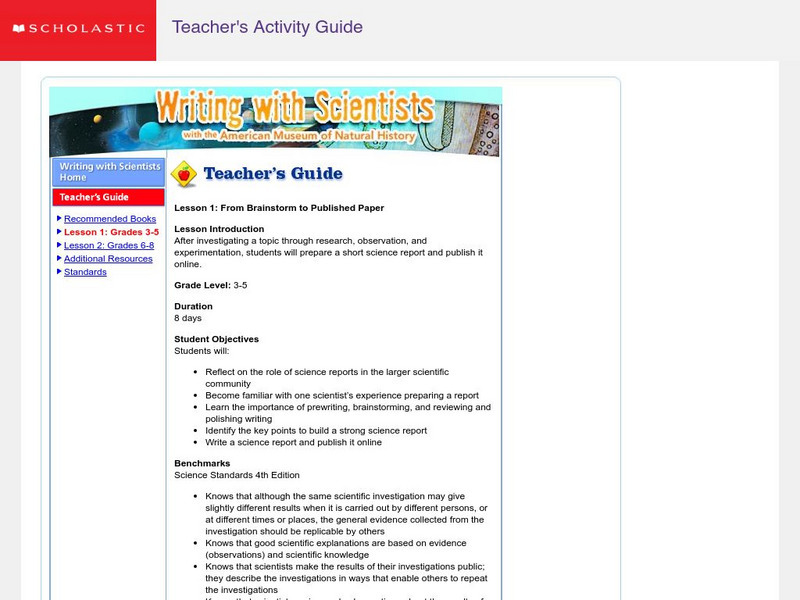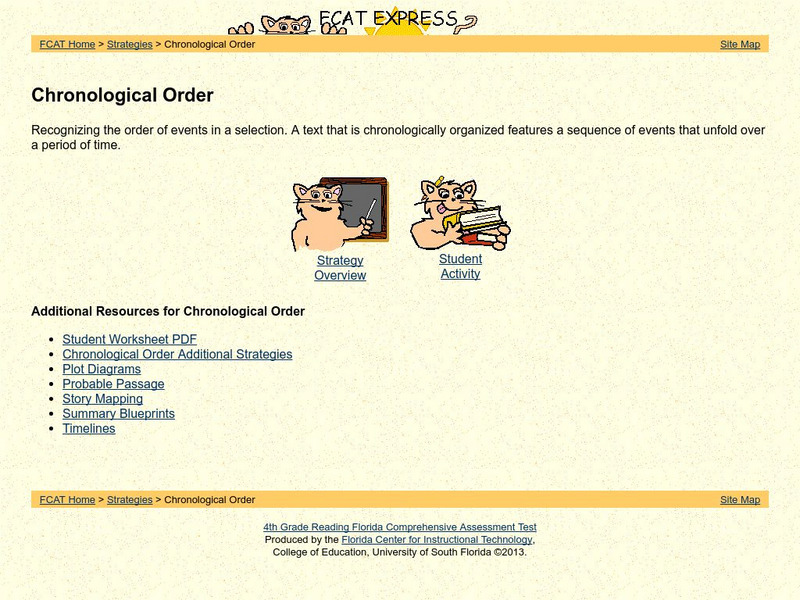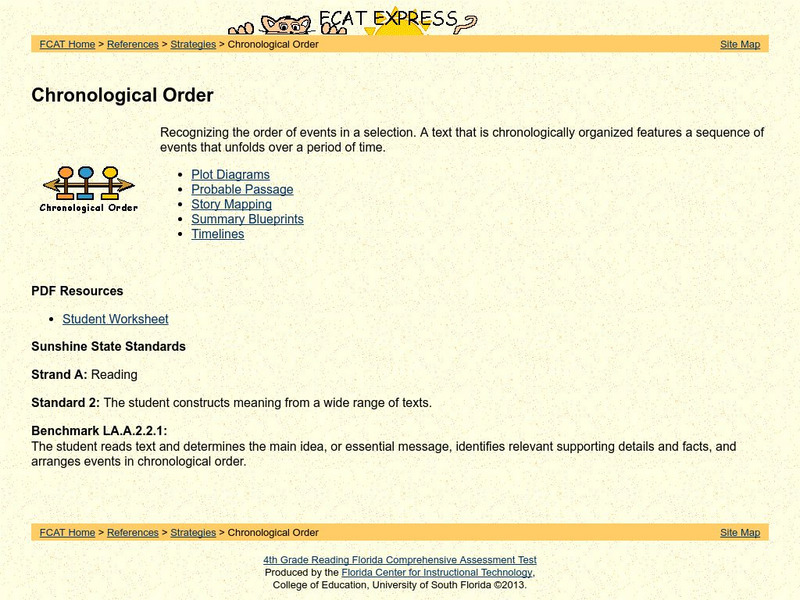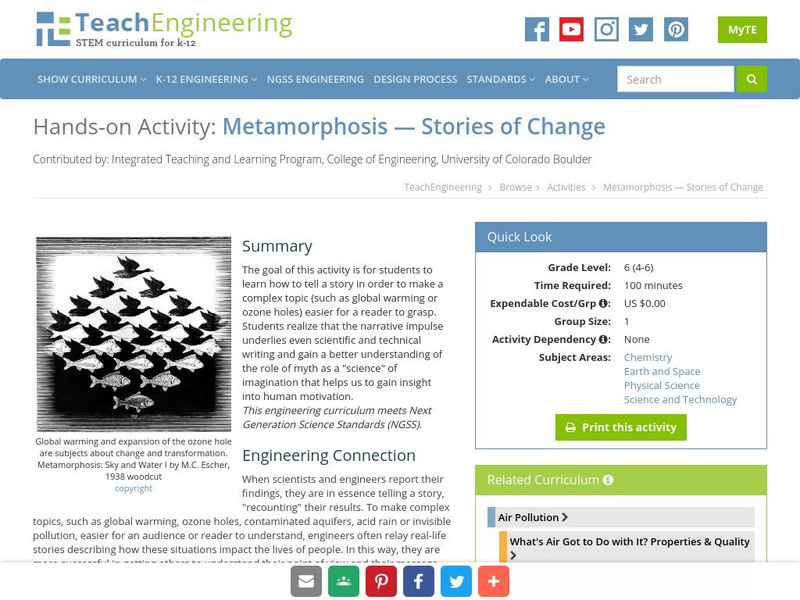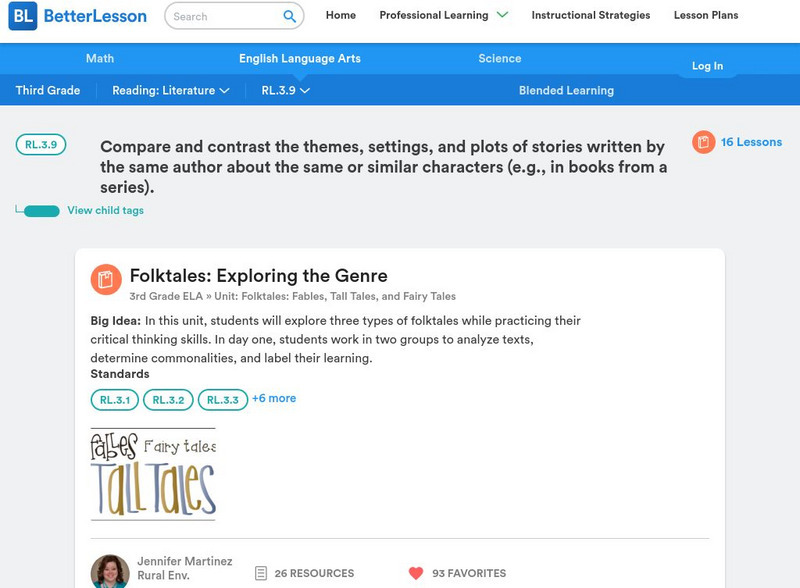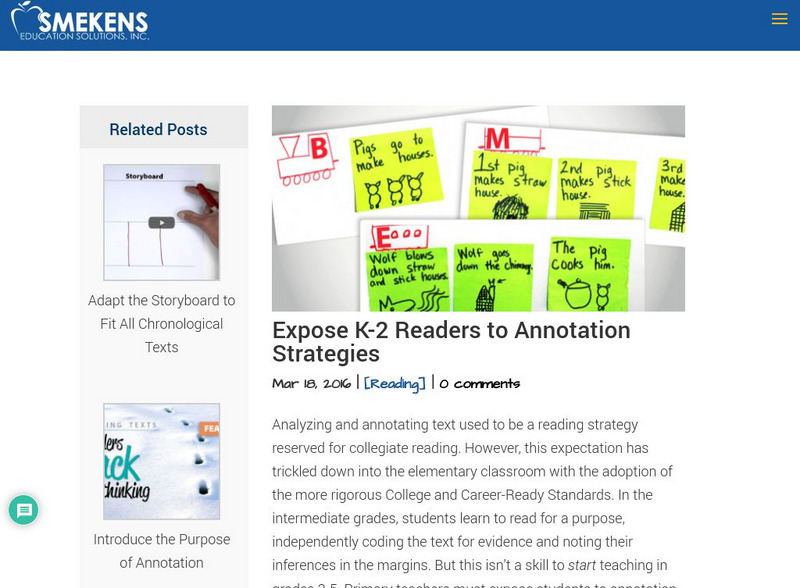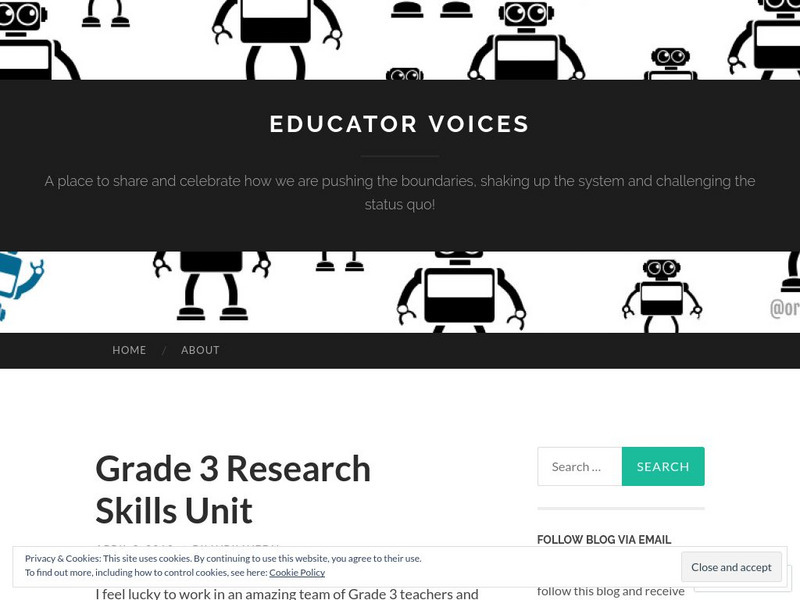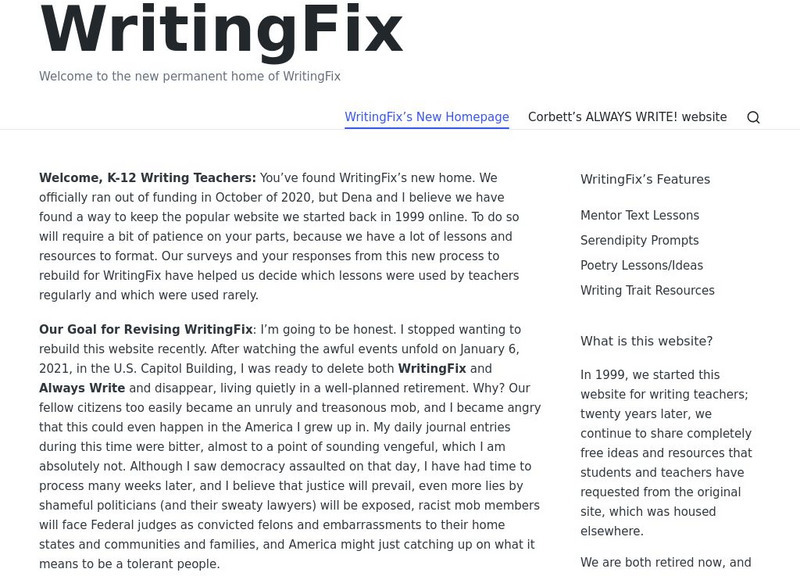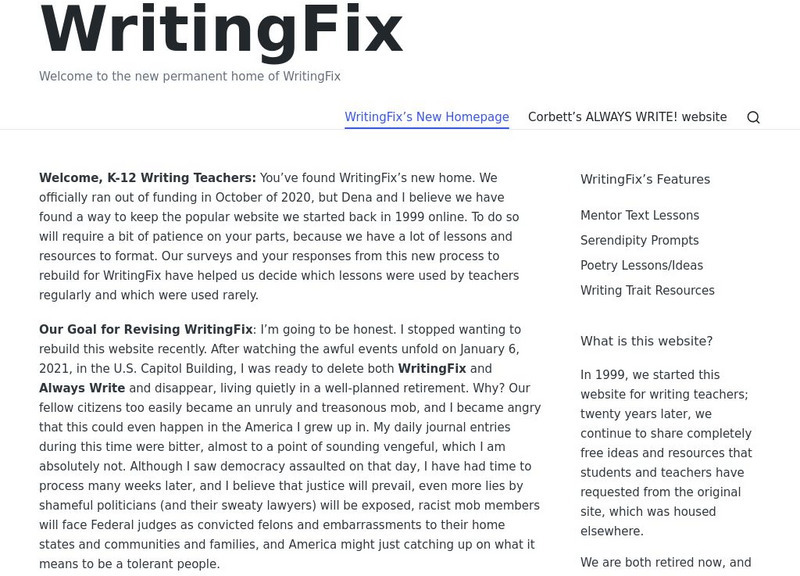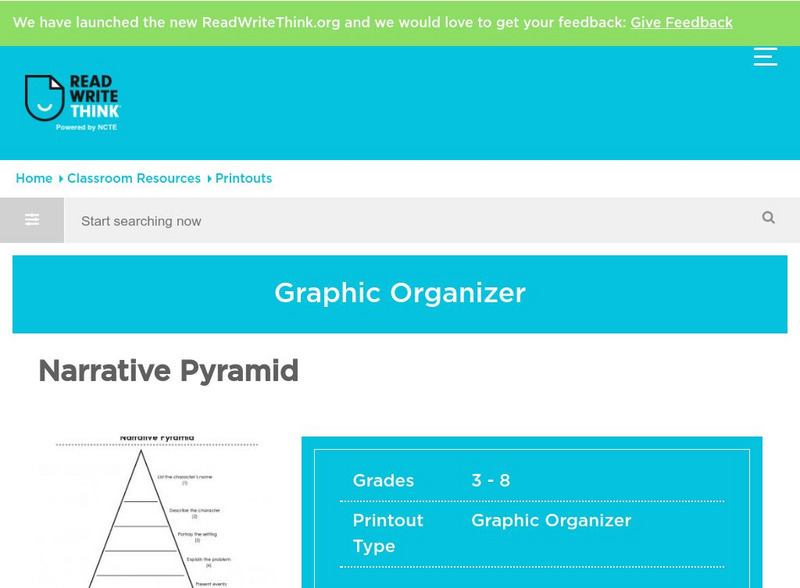Hi, what do you want to do?
University of South Florida
Fcat Express: Plot & Conflict Resolution
Strategies to help students understand the elements of a story provided by a standardized test preparation site intended for fourth grade. Includes strategies such as DLTA/DRTA, Plot Diagrams, Story Clock, Story Mapping, Summary...
Scholastic
Scholastic: Writing With Scientists
After students investigate a topic through research, hypothesizing, observing, and experimentating, teachers can use this lesson to help their students prepare short science reports and publish them online. The Writing with Scientists...
Other
Reading Quest: Strategies for Reading Comp.: History Frames: Story Maps
This activity will help you teach students chronological order as well as identifying key people and events. Printable worksheets.
University of South Florida
Fcat Express: Chronological Order
The site provides extensive assistance in preparing 4th-grade students for Florida Comprehensive Assessment Test. This section focuses on identifying the chronological order.
University of South Florida
Fcat Express: Chronological Order
Strategies to help students recognize the order of events in a selection provided by a standardized test preparation site intended for fourth grade. Includes strategies such as plot diagrams, probable passages, story mapping, summary...
University of South Florida
Fcat Express: Cause and Effect
Site provides extensive assistance in preparing 4th grade students for Florida Comprehensive Assessment Test. This section helps students identify cause and effect in literature.
TeachEngineering
Teach Engineering: Metamorphosis Stories of Change
The goal of this activity is for students to learn how to tell a story in order to make a complex topic (such as global warming or ozone holes) easier for a reader to grasp. Students realize that the narrative impulse underlies even...
TeachEngineering
Teach Engineering: Pingus Penguins: Writing Good Instructions
Students use the free computer game Pingus to learn how engineers, specifically environmental engineers, use their technical writing skills to give instructions and follow the instructions of others. Students learn to write instructions...
Utah Education Network
Uen: Third Grade Writing Lesson #1/ Descriptive Prompt
Given a descriptive writing prompt, 3rd graders will include precise word choices and sensory language in a piece of writing about their favorite place.
Teachers.net
Teachers.net: The Gingerbread Man
Introduce your primary students to retelling and sequencing skills. Will also help move your students to higher-level thinking which deals with characters, setting, and plot. Site offers one week's worth of lessons.
Better Lesson
Better Lesson: Rl.3.9: Compare and Contrast Themes, Settings, and Plots
Links to 16 lessons that focus on skills within third grade reading standard RL.3.9.
Better Lesson
Better Lesson: Tie It Up With Transition Words to Write a Story!
Read, write, and present a digital narrative with transition words to help us put the events in order! After modeling the lesson, groups of students will write narratives to recount a short sequence of events, they will include details...
Other
Smekens Educational Solutions: Expose K 2 Readers to Annotation Strategies
This article discusses how to begin teaching students in K-2 to record their ideas about text using highlighters, colored pens, large graphic organizers, and sticky notes. Students can retell a story with a storyboard, use a web to find...
Other
Educator Voices: Grade 3 Research Skills Unit
Describes the process teachers went through to create a lesson unit where students first brainstormed what it means to do research, then were tasked with choosing a topic, researching it, and presenting on it several days later. The...
Utah Education Network
Uen: Third Grade Writing Lesson #2 / Science Prompt
Third graders will invent a gadget using one or more simple machines and write about it.
Writing Fix
Writing Fix: Moving Through a Machine
After enjoying chapter 3 from Robert McCloskey's classic chapter book Homer Price young scholars will work together to expand upon McCloskey's description of how the donut-making machine works. Focusing on a variety of transitions,...
Writing Fix
Writing Fix: Responding to Comparison/contrast: The Sketch N Write [Pdf]
This is a PDF instructional activity. After studying vocabulary words or concepts that have similarities and differences, students create a two-sided Sketch-n-Write for two or more words (or concepts). On the right-hand side of the...
Writing Fix
Writing Fix: A Picture Book Writing Lesson: Start With What Isn't There
In this lesson, students will describe a setting, attempting to set a mood for their readers in two paragraphs. Borrowing a technique from Stephen Kramer's two-page introduction to Caves, they will begin with a paragraph that explains...
Writing Fix
Writing Fix: An Onomatopoetic Field Trip
In this lesson, students will develop a story incorporating onomatopoeia and strong word choice.
Writing Fix
Writing Fix: Writing Scientific "Recipes"
Adapted from a lesson in the book 51 Wacky We-Search Reports by Barry Lane, this lesson asks students to read several recipes to gain an understanding of how they are written and the types of words they use. Then students demonstrate...
Curated OER
Mc Graw Hill: Part 2 Reading: Informational Text: Cause and Effect Text Structure
Cause and Effect is a text organization structure and knowing this structure can help you in comprehending a text. Learn about these strategies on this site.
Polk Brothers Foundation Center for Urban Education at DePaul University
De Paul University: Center for Urban Education: I Can Draw Conclusions: History Analysis [Pdf]
Graphic organizers are provided to help analyze the importance of people in history and to place events in chronological order. Guiding questions are provided to help guide students
ReadWriteThink
Read Write Think: Narrative Pyramid
A printable narrative pyramid where students can record information about a story including the character, setting, problem, main events, and solution. Directions on how to use this type of graphic organize as well as lists of teaching...
Quia
Quia: Polygon Quiz
In this game, students are to number the steps for making cookies in chronological order to reveal a hidden picture.






